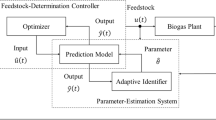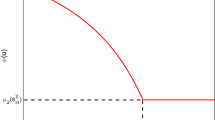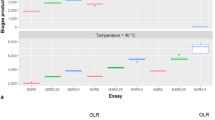Abstract
Current energy demand compels us to develop alternative energy options that reduce environmental pollution concerns and global warming. Biogas is a sustainable energy source mainly made up of methane produced through the anaerobic digestion of organic materials. Biogas modeling may offer dynamic data on the condition of anaerobic fermentation, such as biogas yield forecasts and process optimization. Models can be classified as the comprehensive white-box models (such as the anaerobic digestion model), simplifications and abstractions of grey box anaerobic digestion models (such as optimization), and highly simplified black-box process models (such as Monod’s). Recently, machine learning has developed as a novel technique to model development that might be used to anticipate and regulate anaerobic digestion performance. Biogas modeling may be used to estimate biogas output or enhance the anaerobic digestion process by providing dynamic information on the condition of the anaerobic digestion process. Many operational factors, separately or in combination, can impact anaerobic digestion's effectiveness in terms of biogas output and quality maximization. Improvements in the existing models and the development of new models will always be welcomed for better process control, understanding and prediction.
Access this chapter
Tax calculation will be finalised at checkout
Purchases are for personal use only
Similar content being viewed by others
References
Agustini CB, Spier F, da Costa M, Gutterres M (2018) Biogas production for anaerobic co-digestion of tannery solid wastes under presence and absence of the tanning agent. Resour Conserv Recycl 130:51–59
Akbaş H, Bilgen B, Turhan AM (2015) An integrated prediction and optimization model of biogas production system at a wastewater treatment facility. Bioresour Technolol 196:566–576
Andrews JF (1969) Dynamic model of the anaerobic digestion process. J Sanit Eng Div 95(1):95–116
Andriani D, Wresta A, Atmaja TD, Saepudin A (2014) A review on optimization production and upgrading biogas through CO2 removal using various techniques. Appl Biochem Biotechnol 172:1909–1928
Aragaw T, Gessesse A (2013) Co-digestion of cattle manure with organic kitchen waste to increase biogas production using rumen fluid as inoculums. Inter J Hysical Sci 8:443–450
Balat M, Balat H (2009) Biogas as a renewable energy source—a review. Energy Sour Part A 31(14):1280–1293
Banos R, Manzano-Agugliaro F, Montoya F, Gil C, Alcayde A, Gómez J (2011) Optimization methods applied to renewable and sustainable energy: a review. Renew Sustain Energy Rev 15:1753–1766
Barik D, Murugan S (2015) An artificial neural network and genetic algorithm optimized model for biogas production from co-digestion of seed cake of karanja and cattle dung. Waste Biomass Valorization 6:1015–1027
Batstone DJ, Pind PF, Angelidaki I (2003) Kinetics of thermophilic, anaerobic oxidation of straight and branched chain butyrate and valerate. Biotechnol Bioeng 84(2):195–204
Blumensaat F, Keller J (2005) Modelling of two-stage anaerobic digestion using the IWA Anaerobic Digestion Model No. 1 (ADM1). Wat Res 39:171–183
Bollon J, Le-Hyaric R, Benbelkacem H, Buffiere P (2011) Development of a kinetic model for anaerobic dry digestion processes: focus on acetate degradation and moisture content. Biochem Eng J 56:212–218
Breig SJM, Luti KJK (2021) Response surface methodology: a review on its applications and challenges in microbial cultures. Mater Today: Proc (2021)
Bryant M (1979) Microbial methane production—theoretical aspects. J Anim Sci 48(1):193–201
Chang C-C, Chen W-C, Ho T-F, Wu H-S, Wei Y-H (2011) Development of natural anti-tumor drugs by microorganisms. J Biosci Bioeng 111:501–511
Chibueze U, Okorie N, Oriaku O, Isu J, Peters E (2017) The production of biogas using cow dung and food waste. Inter J Mater Chem 7:21–24
Chiu SL, Lo IM (2016) Reviewing the anaerobic digestion and co-digestion process of food waste from the perspectives on biogas production performance and environmental impacts. Environ Sci Pollut Res 23:24435–24450
De Clercq D, Wen Z, Fei F, Caicedo L, Yuan K, Shang R (2020) Interpretable machine learning for predicting biomethane production in industrial-scale anaerobic co-digestion. Sci Total Environ 712:134574
Dach J, Koszela K, Boniecki P, Zaborowicz M, Lewicki A, Czekała W, Skwarcz J, Qiao W, Piekarska-Boniecka H, Białobrzewski I (2016) The use of neural modelling to estimate the methane production from slurry fermentation processes. Renew Sustain Energy Rev 56:603–610
Derbal K, Bencheikh-Lehocine M, Cecchi F, Meniai A-H, Pavan P (2009) Application of the IWA ADM1 model to simulate anaerobic co-digestion of organic waste with waste activated sludge in mesophilic condition. Biores Technol 100:1539–1543
Dhanya B, Mishra A, Chandel AK, Verma ML (2020) Development of sustainable approaches for converting the organic waste to bioenergy. Sci Total Environ 723:138109
Esposito G, Frunzo L, Giordano A, Liotta F, Panico A, Pirozzi F (2012) Anaerobic co-digestion of organic wastes. Rev Environ Sci Bio/techno 11:325–341
Gaden EL Jr (1959) Fermentation process kinetics. J Biochem Microbiol Technol Eng 1(4):413–429
Gerber M, Span R (2008) An analysis of available mathematical models for anaerobic digestion of organic substances for production of biogas. Proc. IGRC, Paris
Hagos K, Zong J, Li D, Liu C, Lu X (2017) Anaerobic co-digestion process for biogas production: Progress, challenges and perspectives. Renew Sustain Energy Rev 76:1485–1496
Haugen F, Bakke R, Lie B (2013) Adapting dynamic mathematical models to a pilot anaerobic digestion reactor
Isci A, Demirer GN (2007) Biogas production potential from cotton wastes. Renew Energy 32:750–757
Kamalinasab M, Vakili A (2014) Utilization of genetic algorithm to optimize biogas production from livestock waste to use in a CHP Plant in agricultural farms. Biotechnol J Int 1149–1164s
Kiely G, Tayfur G, Dolan C, Tanji K (1997) Physical and mathematical modelling of anaerobic digestion of organic wastes. Water Res 31(3):534–540
Kleerebezem R, Van Loosdrecht M (2006) Waste characterization for implementation in ADM1. Water Sci Technol 54:167–174
Krogh A (2008) What are artificial neural networks? Nat Biotechnol 26:195–197
Kusiak A, Wei X (2014) Prediction of methane production in wastewater treatment facility: a data-mining approach. Ann Oper Res 216:71–81
Kythreotou N, Florides G, Tassou SA (2014) A review of simple to scientific models for anaerobic digestion. Renew Energy 71:701–714
Lakshmi C, Vijayalakshmi S (2017) Studies on biogas production using withered flowers as a substrate. Res J Pharm Technol 10:4223–4226
Lauwers J, Appels L, Thompson IP, Degrève J, Van Impe JF, Dewil R (2013) Mathematical modelling of anaerobic digestion of biomass and waste: power and limitations. Prog Energy Combust Sci 39:383–402
Lawrence AW, McCarty PL (1969) Kinetics of methane fermentation in anaerobic treatment. J Water Pollut Control Fed R1-R17
Li C, Bai J, Cai Z, Ouyang F (2002) Optimization of a cultural medium for bacteriocin production by Lactococcus lactis using response surface methodology. J Biotechnol 93:27–34
Lindmark J, Thorin E, Fdhila RB, Dahlquist E (2014) Effects of mixing on the result of anaerobic digestion. Renew Sustain Energy Rev 40:1030–1047
Lindmark J, Bel Fdhila R, Thorin E (2009) On modelling the mixing in a digester for biogas production. In: MATHMOD 09, 6th international conference on mathematical modelling. Vienna, Austria
Lindmark J, Bel Fdhila R, Thorin E (2011) Retention time and nutrient tracking inside a digester for biogas production. In: 52nd international conference of scandinavian simulation society ScanSIMS, pp 29–30
Loganath R, Mazumder D (2020) Development of a simplified mathematical model for anaerobic digestion. In: Sustain Waste Manage Policies Case Stud, Springer, pp 571–578
Lübken M, Wichern M, Schlattmann M, Gronauer A, Horn H (2007) Modelling the energy balance of an anaerobic digester fed with cattle manure and renewable energy crops. Water Res 41:4085–4096
Markowski M, Białobrzewski I, Zieliński M, Dębowski M, Krzemieniewski M (2014) Optimizing low-temperature biogas production from biomass by anaerobic digestion. Renew Energy 69:219–225
McLeod JD, Othman MZ, Beale DJ, Joshi D (2015) The use of laboratory scale reactors to predict sensitivity to changes in operating conditions for full-scale anaerobic digestion treating municipal sewage sludge. Biores Technol 189:384–390
Mendes C, da Silva Magalhes R, Esquerre K, Queiroz LM (2015) Artificial neural network modeling for predicting organic matter in a full-scale up-flow anaerobic sludge blanket (UASB) reactor. Environ Model Assess 20:625–635
Meroney RN, Colorado P (2009) CFD simulation of mechanical draft tube mixing in anaerobic digester tanks. Water Res 43:1040–1050
Monod J (1949) The growth of bacterial cultures: annual reviews in microbiology 3
Montgomery DC, Peck EA, Vining GG (2021) Introduction to linear regression analysis. Wiley, New York
Morales-Polo C, Cledera-Castro MDM, Moratilla Soria BY (2018) Reviewing the anaerobic digestion of food waste: from waste generation and anaerobic process to its perspectives. Appl Sci 8:1804
Mosey F (1983) Mathematical modelling of the anaerobic digestion process: regulatory mechanisms for the formation of short-chain volatile acids from glucose. Water Sci Technol 15(8–9):209–232
Nair VV, Dhar H, Kumar S, Thalla AK, Mukherjee S, Wong JW (2016) Artificial neural network based modeling to evaluate methane yield from biogas in a laboratory-scale anaerobic bioreactor. Biores Technol 217:90–99
Portugal I, Alencar P, Cowan D (2018) The use of machine learning algorithms in recommender systems: a systematic review. Expert Syst Appl 97:205–227
Qdais HA, Hani KB, Shatnawi N (2010) Modeling and optimization of biogas production from a waste digester using artificial neural network and genetic algorithm. Resour Conserv Recycl 54:359–363
Ramachandran A, Rustum R, Adeloye AJ (2019) Review of anaerobic digestion modeling and optimization using nature-inspired techniques. Processes 7:953
Ramírez J, Santos I, Morales O, Morrissey M, Vázquez M (2000) Application of microbial transglutaminase to improve mechanical properties of surimi from silver carp utilizaciónde transglutaminasa microbiana paramellora-laspropiedades mecánicas de surimide carpaplateada utilizaciónde transglutaminasamicrobiana paramejorarlaspropiedades mecánicas de surimide carpaplateada. CYTA-J Food 3:21–28
Shin H-S, Song Y-C (1995) A model for evaluation of anaerobic degradation characteristics of organic waste: focusing on kinetics, rate-limiting step. Environ Technol 16(8):775–784
Stazi V, Tomei MC (2018) Enhancing anaerobic treatment of domestic wastewater: state of the art, innovative technologies and future perspectives. Sci Total Environ 635:78–91
Thorin E, Nordlander E, Lindmark J, Dahlquist E, Yan J, Bel Fdhila R (2012) Modeling of the biogas production process-a review. In: International conference on applied energy ICAE 2012, Suzhou, China, 5–8 Jul 2012
Tortora GJ, Funke BR, Case CL, Weber D, Bair W (2004) Microbiology: an introduction. Benjamin Cummings San Francisco, CA
Veeken A, Hamelers B (1999) Effect of temperature on hydrolysis rates of selected biowaste components. Biores Technol 69(3):249–254
Velázquez-Martí B, Meneses-Quelal OW, Gaibor-Chavez J, Niño-Ruiz Z (2018) Review of mathematical models for the anaerobic digestion process. In: Anaerobic digestion, IntechOpen
Walid F, El Fkihi S, Benbrahim H, Tagemouati H (2021) Modeling and optimization of anaerobic digestion: a review. In: E3S web of conferences. EDP Sciences, p 01022
Wang X, Yang G, Li F, Feng Y, Ren G, Han X (2013) Evaluation of two statistical methods for optimizing the feeding composition in anaerobic co-digestion: Mixture design and central composite design. Biores Technol 131:172–178
Wang L, Long F, Liao W, Liu H (2020) Prediction of anaerobic digestion performance and identification of critical operational parameters using machine learning algorithms. Bioresour Technol 298:122495
Ward A (2010) Biogas potential of fish wax with cattle manure. Department of Biosystems Engineering, Fakulty of Agricultural Sciences, University of Aarhus, Internal Report-Animal Science
Wu B (2012) CFD simulation of mixing for high-solids anaerobic digestion. Biotechnol Bioeng 109:2116–2126
**e S, Hai FI, Zhan X, Guo W, Ngo HH, Price WE, Nghiem LD (2016) Anaerobic co-digestion: a critical review of mathematical modelling for performance optimization. Biores Technol 222:498–512
Yan N, Ren B, Wu B, Bao D, Zhang X, Wang J (2016) Multi-objective optimization of biomass to biomethane system. Green Energy Environ 1:156–165
Yu L, Wensel PC, Ma J, Chen S (2013) Mathematical modeling in anaerobic digestion (AD). J Bioremed Biodegradation S 4
Zagorskis A, Baltrėnas P, Misevičius A, Baltrėnaitė E (2012) Biogas production by anaerobic treatment of waste mixture consisting of cattle manure and vegetable remains. Environ Eng Manag J 11:849–856
Zhang Q, Hu J, Lee D-J (2016) Biogas from anaerobic digestion processes: research updates. Renew Energy 98:108–119
Zhou H, Löffler D, Kranert M (2011) Model-based predictions of anaerobic digestion of agricultural substrates for biogas production. Biores Technol 102:10819–10828
Acknowledgements
Ms. Venkata Naga Surya Gunasri Appala acknowledges Dr. B.R. Ambedkar National Institute of Technology Jalandhar for providing financial support from the Ministry of Education (MoE), Govt. of India.
Author information
Authors and Affiliations
Corresponding author
Editor information
Editors and Affiliations
Rights and permissions
Copyright information
© 2022 The Author(s), under exclusive license to Springer Nature Singapore Pte Ltd.
About this chapter
Cite this chapter
Appala, V.N.S.G., Pandhare, N.N., Bajpai, S. (2022). Mathematical Models for Optimization of Anaerobic Digestion and Biogas Production. In: Nandabalan, Y.K., Garg, V.K., Labhsetwar, N.K., Singh, A. (eds) Zero Waste Biorefinery. Energy, Environment, and Sustainability. Springer, Singapore. https://doi.org/10.1007/978-981-16-8682-5_21
Download citation
DOI: https://doi.org/10.1007/978-981-16-8682-5_21
Published:
Publisher Name: Springer, Singapore
Print ISBN: 978-981-16-8681-8
Online ISBN: 978-981-16-8682-5
eBook Packages: EngineeringEngineering (R0)




